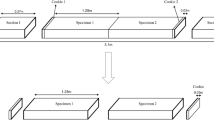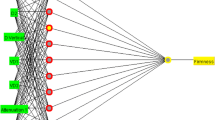Abstract
Elastic strain is one of the most important parameters associated with drying stresses. The research presented in this paper attempts to develop an artificial neural network based model for predicting elastic strain in white birch (Betula platyphylla Suk) disks during drying as a function of temperature, moisture content, relative humidity and distance from the pith. The data set was obtained by using image analysis method under two drying schedules and divided into three subsets for training (60%), validation (20%) and test (20%). According to the results, the values of determination coefficient (R2) obtained were greater than 0.97, 0.96 and 0.95 for the training, validation and test sets, respectively.






Similar content being viewed by others
References
Aghbashlo M, Hosseinpour S, Mujumdar AS (2015) Application of artificial neural networks (ANNs) in drying technology: a comprehensive review. Dry Technol 33(12): 1397–1462
Avramidis S, Iliadis L (2005a) Predicting wood thermal conductivity using artificial neural networks. Wood Fiber Sci 37: 682–690
Avramidis S, Iliadis L (2005b) Wood-water sorption isotherm prediction with artificial neural networks: a preliminary study. Holzforschung 59:336–341
Avramidis S, Iliadis L, Mansfield SD (2006) Wood dielectric loss factor prediction with artificial neural networks. Wood Sci Technol 40:563–574
Ceylan I (2008) Determination of drying characteristics of timber by using artificial neural networks and mathematical models. Dry Technol 26: 1469–1476
Esteban LG, Fernandez FG, Palacios PD (2009) MOE prediction in Abies pinsapo Boiss. timber: application of an artificial neural network using non-destructive testing. Comput Struct 87:1360–1365
Ferrari S, Pearson H, Allegretti O, Gabbitas B (2010) Measurement of internal stress in Radiata pine sapwood during drying using an improved online sensor. Holzforschung 64:781–789
Fu ZY, Zhao JY, Huan SQ, Sun XM, Cai YC (2015) The variation of tangential rheological properties caused by shrinkage anisotropy and moisture content gradient in white birch disks. Holzforschung 69(5):573–579
Gerhards CC (2007) Effect of moisture content and temperature on the mechanical properties of wood: an analysis of immediate effects. Wood Fiber Sci 14(1):4–36
Hagan MT, Demuth HB, Beale MH (1996) Neural network design. PWS Publishing Company, Boston
Iliadis L, Mansfield SD, Avramidis S, El-Kassaby Y (2013) Predicting Douglas-fir wood density by artificial neural networks (ANN) based on progeny testing information. Holzforschung 67(7):771–777
Kang W, Lee NH (2002) Mathematical modeling to predict drying deformation and stress due to the differential shrinkage within a tree disk. Wood Sci Technol 36:463–476
Korai H, Watanabe K (2016) Predicting the strength reduction of particleboard subjected to various climatic conditions in Japan using artificial neural networks. Eur J Wood Prod. doi:10.1007/s00107-016-1056-8
Larsen F, Ormarsson S (2013) Numerical and experimental study of moisture-induced stress and strain field developments in timber logs. Wood Sci Technol 47:837–852
Lazarescu C, Avramidis S (2010) Modeling shrinkage response to tensile stresses in wood drying: II. Stress-shrinkage correlation in restrained specimens. Dry Technol 28(2):186–192
Lazarescu C, Avramidis S, Oliveira L (2009) Modeling shrinkage response to tensile stresses in wood drying: I. Shrinkage-moisture interaction in stress-free specimens. Dry Technol 27(11):1183–1191
Lazarescu, C, Avramidis S, Oliveira L (2010) Modeling shrinkage response to tensile stresses in wood drying: III. Stress-tensile set correlation in short pieces of lumber. Dry Technol 28(6):745–751
Mansfield SD, Iliadis L, Avramidis S (2007) Neural network prediction of bending strength and stiffness in western hemlock (Tsuga heterophylla Raf.). Holzforschung 61:707–716
Moutee M, Fafard M, Fortin Y (2005) Modeling the creep behavior of wood cantilever loaded at free end during drying. Wood Fiber Sci 37(3):521–534
Moutee M, Fortin Y, Fafard M (2007) A global rheological model of wood cantilever as applied to wood drying. Wood Sci Technol 41:209–234
Myhara RM, Sablani S (2001) Unification of fruit water sorption isotherm using artificial neural networks. Dry Technol 19(8):1543–1554
Perré P, Passard J (2004) A physical and mechanical model able to predict the stress field in wood over a wide range of drying conditions. Dry Technol 22:27–44
Salinas C, Chavez C, Ananias RA, Elustondo D (2015) Unidimensional simulation of drying stress in radiata pine wood. Dry Technol 33(8):996–1005
Sarle WS (1995) Stopped training and other remedies for overfitting. In: Proceedings of the 27th Symposium on the Interface of Computing Science and Statistics, pp 352–360
Simpson W (2001) Chap. 08 drying defects. USDA Agricultural Handbook No. 188: Dry Kiln Operator’s Manual. Wisconsin, Madison, pp 179–205
Svensson S (1995) Strain and Shrinkage force in wood under kiln drying conditions. I: Equipment and preliminary results. Holzforschung 49(4):363–368
Svensson S (1996) Strain and shrinkage force in wood under kiln drying conditions. II: Measuring strains and shrinkage under controlled climate conditions. Holzforschung 50(5):463–469
Svensson S, Mårtensson A (1999) Simulation of drying stresses in wood Part I: comparison between one and two dimensional models. Holz Roh-Werkst 57(2):129–136
Svensson S, Mårtensson A (2002) Simulation of drying stresses in wood Part II: convective air drying of sawn timber. Holz Roh-Werkst 60(1):72–80
Tiryaki S, Aydın A (2014) An artificial neural network model for predicting compression strength of heat treated woods and comparison with a multiple linear regression model. Constr Build Mater 62:102–108
Tiryaki S, Hamzaçebi C (2014) Predicting modulus of rupture (MOR) and modulus of elasticity (MOE) of heat treated woods by artificial neural networks. Measurement 49:266–274
Tiryaki S, Ozşahin S, Aydın A (2016) Employing artificial neural networks for minimizing surface roughness and power consumption in abrasive machining of wood. Eur J Wood Prod. doi:10.1007/s00107-016-1050-1
Watanabe K, Kobayashi I, Saito S, Kuroda N, Noshiro S (2013a) Nondestructive evaluation of drying stress level on wood surface using near-infrared spectroscopy. Wood Sci Technol 47(2):299–315
Watanabe K, Matsushita Y, Kobayashi I, Kuroda N (2013b) Artificial neural network modeling for predicting final moisture content of individual Sugi (Cryptomeria japonica) samples during air-drying. J Wood Sci 59:112–118
Wu H, Avramidis S (2006) Prediction of timber kiln drying rates by neural networks. Dry Technol 24(12):1541–1545
Zhang Z, Friedrich K (2003) Artificial neural networks applied to polymer composites: a review. Compos Sci Technol 63:2029–2044
Acknowledgements
This study is financially supported by the Fundamental Research Funds for the Central Universities of China (Grant No. 2572015AB08).
Author information
Authors and Affiliations
Corresponding author
Rights and permissions
About this article
Cite this article
Fu, Z., Avramidis, S., Zhao, J. et al. Artificial neural network modeling for predicting elastic strain of white birch disks during drying. Eur. J. Wood Prod. 75, 949–955 (2017). https://doi.org/10.1007/s00107-017-1183-x
Received:
Published:
Issue Date:
DOI: https://doi.org/10.1007/s00107-017-1183-x




